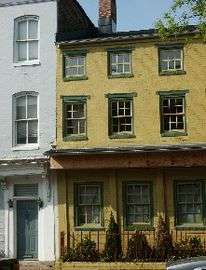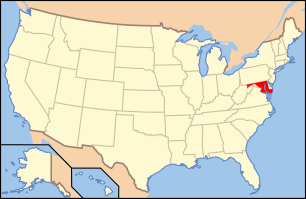Seton Hill Historic District
|
Seton Hill Historic District | |
|
Eutaw Street in the Seton Hill Historic District, August 2011 | |
   | |
| Location | Bounded by Pennsylvania Ave., Franklin, Eutaw, McCulloh, and Orchard Sts., Baltimore, Maryland |
|---|---|
| Coordinates | 39°17′47″N 76°37′24″W / 39.29639°N 76.62333°WCoordinates: 39°17′47″N 76°37′24″W / 39.29639°N 76.62333°W |
| Area | 25 acres (10 ha) |
| Built | 1800 |
| NRHP Reference # | 75002099[1] |
| Added to NRHP | July 30, 1975 |
Seton Hill Historic District is a historic district in Baltimore, Maryland. It was listed on the National Register of Historic Places in 1975.[1]
It includes St. Mary's Seminary Chapel, which is a National Historic Landmark. It also includes Mother Seton House, separately listed on the National Register.
Seton Hill, Baltimore’s former French Quarter, is centered on the former St. Mary's Seminary and College, which was founded by Sulpician priests fleeing the French Revolution around 1791. Today Saint Mary’s Park is situated where the former Seminary and College once stood. The neighborhood was designated as an Historic and Architectural Preservation District of Baltimore City in 1968, and was placed on the National Register of Historic Places in 1975. Saint Mary's Park, the heart of Seton Hill, is the largest open green space in downtown Baltimore on the West Side. n 1790 Bishop John Carroll met with Father Nagot of the Order of St. Sulpice and agreed to a plan for the establishment of the Sulpician Order in Maryland. A year later Fathers Nagot, Tessier, Garnier, and Levadoux opened the Sulpician headquarters in One Mile Tavern then located at Franklin Street and Hookstown Road, known today as Pennsylvania Avenue. The Sulpicians soon purchased the inn, adapting it to a seminary, and in future years they completed an extensive college and seminary complex in the area of the existing Seminary structures. St. Mary's thus became the first Catholic seminary in the United States, celebrating its 175th anniversary in 1966. One particularly significant structure located on the Seminary grounds is a small chapel, the Chapel of Our Lady of the Presentation, which was dedicated in 1808. This structure, designed by Maximilien Godefroy, a prominent architect of the time and teacher at the college, is the oldest remaining example of Gothic Revival architecture in the U.S.[2][3]
.jpg) Chapel of the former Seminary
Chapel of the former Seminary Mother Seton House
Mother Seton House
 Paca Street
Paca Street Orchard Street Church
Orchard Street Church Druid Hill Ave
Druid Hill Ave Druid Hill Ave home
Druid Hill Ave home
References
- 1 2 National Park Service (2010-07-09). "National Register Information System". National Register of Historic Places. National Park Service.
- ↑ Live Baltimore: http://livebaltimore.com/neighborhoods/seton-hill/#.UqnMqY1gNg0
- ↑ Joyce Mcclay and Catharine Black (January 1973). "National Register of Historic Places Registration: Seton Hill Historic District" (PDF). Maryland Historical Trust. Retrieved 2016-03-01.
External links
- Seton Hill Historic District, Baltimore City, including photo dated 1975, at Maryland Historical Trust, and accompanying map


